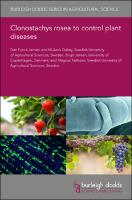Clonostachys rosea to control plant diseases
Author(s)
Funck Jensen, Dan
Dubey, Mukesh
Jensen, Birgit
Karlsson, Magnus
Language
EnglishAbstract
The fungus Clonostachys rosea was recognized as an aggressive parasite on other fungi already in the late 1950s. Research into its potential use in biological control of plant diseases soon followed. Today, there are several commercial products based on C. rosea available for biocontrol applications worldwide. Although its mycoparasitic ability has attracted a lot of interest, C. rosea is now viewed as an ecological generalist whose lifestyle also includes plant endophytism, rhizosphere competence and polyphagous ability. Protocols for producing high amounts of C. rosea spores are available for both solid state and liquid fermentation. Low temperature and low moisture content are key factors that influence the shelf life of C. rosea propagules. Products based on C. rosea can be delivered to flowers using bumble bees, applied by spraying or as seed dressing or by incorporation into the soil. Clonostachys rosea is today an established factor in sustainable plant protection strategies.
Keywords
Biological control; Clonostachys; plant disease; formulation; fungi; mycoparasitismDOI
10.19103/AS.2021.0093.14ISBN
9781801462020, 9781801462020Publisher
Burleigh Dodds Science PublishingPublisher website
https://bdspublishing.com/Publication date and place
Cambridge, 2022Imprint
Burleigh Dodds Science PublishingSeries
Burleigh Dodds Series in Agricultural Science,Classification
Agronomy and crop production
Sustainable agriculture
Pest control / plant diseases
Botany and plant sciences


 Download
Download